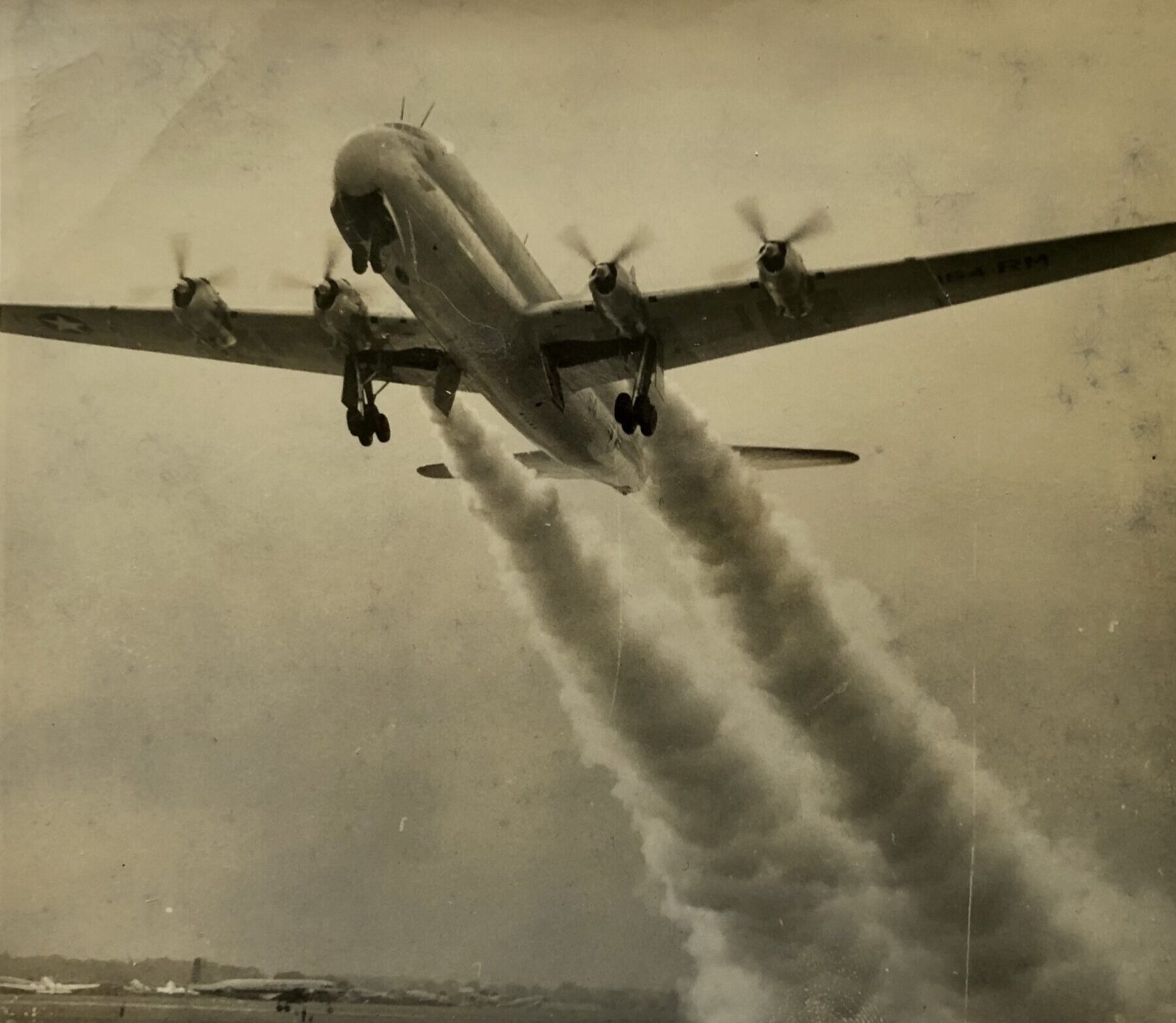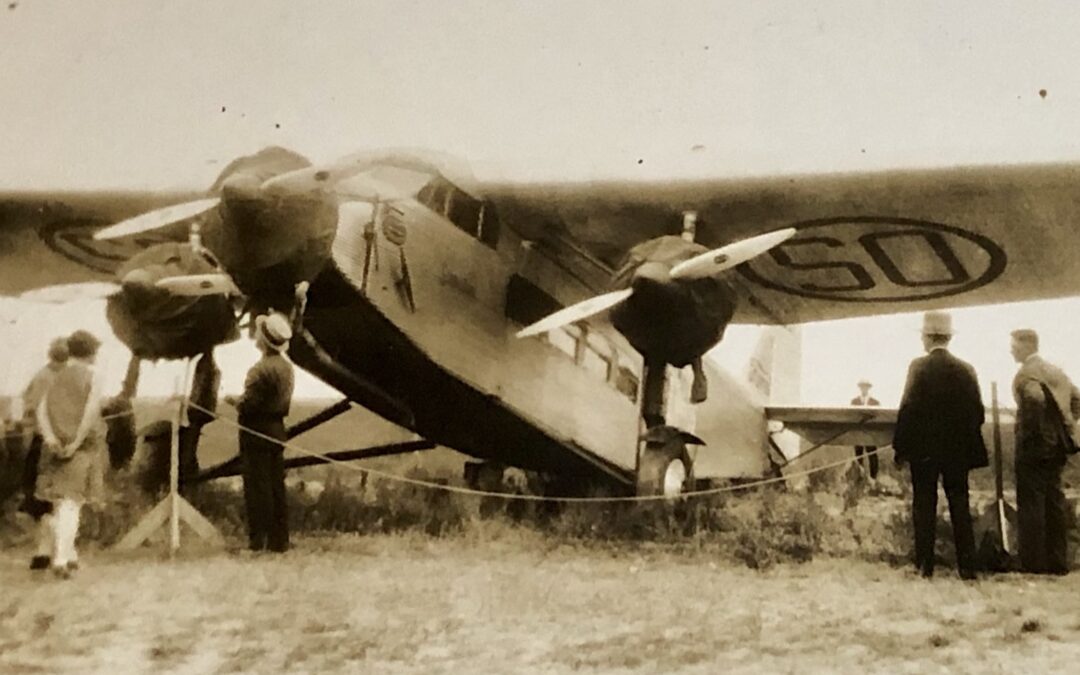
This original photo of the Curtiss Condor B-2 bomber was taken at the Curtiss Aerospace development plant in Garden City, N.Y. The image is dated Aug. 14, 1929. (Photo from the Paul S. Maynard archive)
The Curtiss Condor B-2 bomber became known as a ‘Flying Battleship’
Long before the current-generation B2 Spirit “Stealth Bomber” by Northrop Grumman there was the Curtiss Condor B-2 bomber built for the U.S. Army.
It was an enormous fabric-covered biplane aircraft with a wingspan of 90 feet and a length of 47 feet 4 inches. With its armaments, it became known as a “Flying Battleship,” but its use was short-lived.
According to its page in Wikipedia, the B-2 Condor’s two engines sat in nacelles between the wings, flanking the fuselage. It had a twin set of rudders on a twin tail, a configuration that was becoming obsolete by that time. At the rear of each nacelle was a gunner position. And there was another gunner in the nose.
As a twin-engine heavy bomber, the B-2 Condor was powered by two 650-horsepower Curtiss GV-1570-7 Conqueror V-12 water-cooled piston engines.
In a report by Joe Baugher (Encyclopedia of American Aircraft), the engines were housed inside nacelles mounted on top of the lower wing. “The engines were cooled by rather angular radiators that jutted up vertically from each nacelle.
“One of the more unusual innovations introduced by the [second prototype] XB-2 was the addition of a defensive gunner position in the rear of each nacelle. It was hoped that this arrangement would offer a clearer field of fire for the gunners than the more conventional fuselage-situated positions. An additional gunner position was provided in the nose. Each position was provided with a pair of Lewis .30-06 machine guns.”
According to the Baugher report, the Condor’s bombload was typically 2,508 pounds but could be increased to 4,000 pounds on short flights.
Curtiss Condor Competitors
The Curtiss Condor B-2 competed against the Keystone XB-1B, the Keystone XLB-6, the Sikorsky S-37B, and the Atlantic-Fokker XLB-2, according to the Baugher report.
“When an Army board of review met in February of 1928 to decide which design was to be awarded a contract, they immediately ruled out the XB-1B, the XLB-2, and the S-37. However, the board was unable to decide between the XB-2 and the XLB-6. The XB-2 had the better performance, but the XLB-6 was only $24,750 per unit.
“The per-unit cost of the B-2 was $76,373, more than three times the cost of a Keystone bomber. In a split decision, the Board opted for the Keystone design, but on June 23, 1928, Curtiss was given a contract for two B-2s (Serial nos. 28-398/399). A further 10 were ordered in 1929 (29-28/37).
“The twelve production B-2s were delivered from May 1929 to January 1930. Notable differences from the XB-2 included the use of three-bladed propellers and somewhat shorter and wider radiators mounted on top of the engine nacelles.
At sea level, the Curtiss Condor had a maximum speed of 132 mph — though many reports say it struggled to reach that max V — and 128 mph at 5,000 feet. The plane had a cruising speed of 105.5 mph and a cruising range of 805 miles.
End of the Condor Line
During the early 1930s, the advances in bomber design were so rapid that canvas-covered biplanes such as the B-2 rapidly became obsolete, Baugher wrote.
“Consequently, the B-2 served only briefly with the Army, being taken out of service in 1934. The last B-2 was surveyed in July of 1936. So far as I am aware, none survives today.”
After production of the B-2, Curtiss Aircraft left the bomber business, concentrating on the Hawk series of pursuit aircraft in the 1930s.

The civilian version of the Curtiss Condor, circa 1944, was the first airliner in the world to provide sleeping berths. (Photo from the Paul S. Maynard archive)
The Civilian Curtiss Condor
The Model 53 was an airliner version of the Model 52 Condor B-2 bomber. The Condor was the first airliner in the world to provide sleeping berths.
The Army permitted this development in 1928, and the first of the new aircraft made its maiden flight in June 1929. The civilian B-2 was an 18-seat passenger aircraft called the Condor 18 (also known as the Condor T32), according to HistoryOfWar.org.
At the time, there was a need for sleeper-transports, and the simplicity of design allowed for quick production and delivery to serve this market, according to HistoryOfWar. The Curtiss Condor could carry 12 passengers as a sleeper-transport or 15 passengers for day transport.
Luxury Cabin Accommodations
The Condor was the first multi-engine airliner with an electrically operated retractable landing gear. To help absorb vibration, the Condor was the first to have its engines mounted on rubber bushings.
The passenger cabin was appointed in fabric and leather, and each seat had individual hot and cold air vents.
The lavatory featured a basin with hot and cold running water, a mirror, and a vanity. However, the Condor remained in airline service for only three years, making it the last biplane purchased for civil transport.
Only a short time afterward, the all-metal airliners, the Boeing 247 and Douglas DC-1, made their debut in 1933. The only competing factor that the Condor had with the modern airplanes was that it had retractable landing gear.
Two 710 hp Wright SCR-1820-F3 Cyclone, 9-cylinder radial engines powered the passenger Condor.
Condor Flight History
The first civilian Condor converted from a military Model 52, flew for the first time on July 21, 1929. Including the prototype, six were built. Of these, the first three were converted from bomber model 52s. They operated with TAT and Eastern Air Line, though only for about a year. The Conqueror’s development was never quite completed, and in 1932 the US Army, after spending large sums on it, withdrew support and turned to air-cooled engines.
CURTISS B-2 CONDOR SPECIFICATIONS
Twin-engine heavy bomber biplane. Initial production version; 12 built.
Crew: 5; two wing gunners, the nose gunner, pilot, and co-pilot.
Length: 47 feet 4 inches
Wingspan: 90 feet
Empty weight: 9,300 pounds
Gross weight: 16,951 pounds
Powerplant: 2 × Curtiss GV-1570-7 Conqueror V-12 water-cooled piston engine, 600 hp each
PERFORMANCE
Maximum speed: 132 mph
Cruising speed: 105.5 mph
Range: 805 miles
Service ceiling: 17,100 feet
Rate of climb: 850 feet/minute
ARMAMENT
Guns: 6 .30-06 caliber Lewis machine-guns
Bombload: 2,508 pounds
Note: This is another image from my dad, Paul Smith Maynard, who worked four decades in aviation as an engineer. Dad began his career in about 1943 after graduating from West Virginia University. He started with Curtiss-Wright Corp., a pioneer in making flying machines. He went on to work at North American Aviation and Rockwell International.
See more of his vintage plane pics here.




















